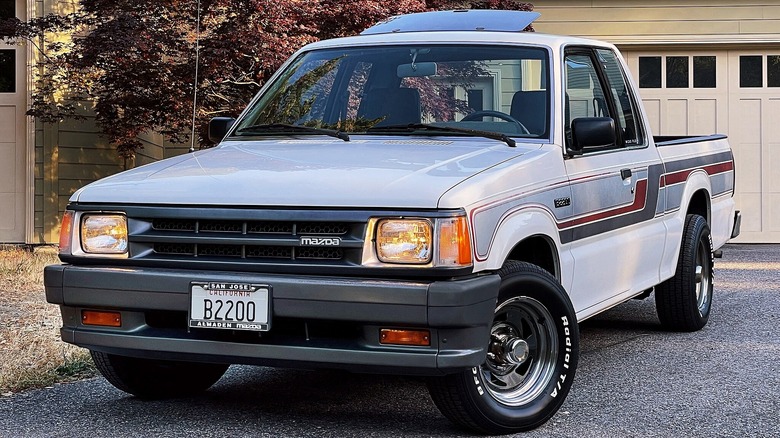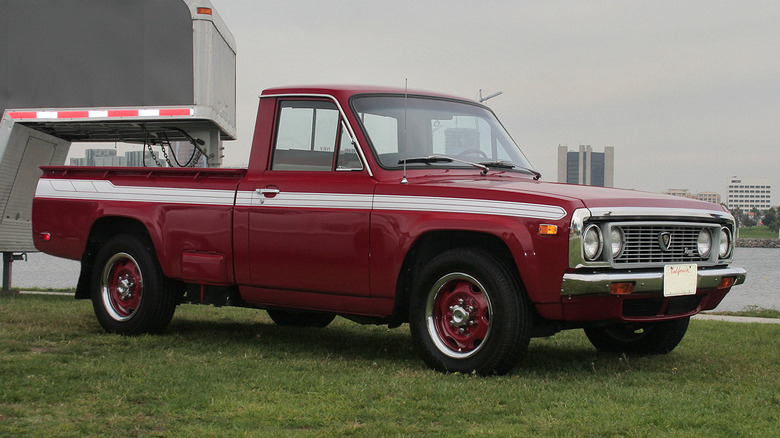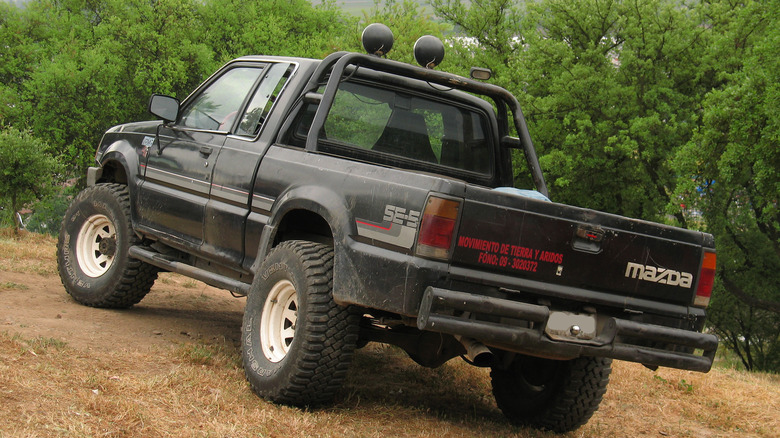The Classic Mini-Truck We Wish Mazda Would Bring Back
As a brand, Mazda has gone to great lengths to cultivate its image as a purveyor of sporty, fun-to-drive vehicles. Case in point is its Miata roadster, the iconic rotary-engine RX-7 hatchback, and a catchy Zoom-Zoom ad campaign. But did you know that Mazda has produced pickup trucks since the late-1950s?
Introduced to the American market in 1972, Mazda's B-series was largely overshadowed by Ford's Courier, a rebadged version of the same truck but sold with the name recognition and dealership support of the Blue Oval brand. One interesting twist during this era was that between 1974 and 1977, Mazda marketed an exclusive and quirky version of the little pickup truck with a rotary engine, appropriately called the Rotary Pickup.
Besides the Wankel rotary engine lifted directly from Mazda's RX-4 line of cars, the Rotary Pickup was five to six inches wider than its piston-engine counterpart, with bulging fender flares covering a beefier-than-usual set of wheels and tires. A bespoke front grill and air intake were fitted, as were a larger fuel tank and front disc brakes instead of drums.
The Rotary Pickup's larger fuel tank would come in handy since the mini-truck was only capable of about 10 MPG fuel economy, which was on par with full-size V8-powered American trucks at the time. With the 1970s gas crunch in full swing, the Rotary Pickup's thirst for fuel was a real deal-killer, and only about 15,000 were built across all model years.
[Featured image by Shervin Nakhjavani via Wikimedia Commons | Cropped and scaled | CC BY-SA 4.0]
Mazda's truck finds its own identity
Following the rotary-engine experiment, Mazda's B-series truck continued to slog along in the shadow of its Ford Courier sibling. Both trucks had a major redesign in 1977 with boxier, refreshed styling. In 1980, the B-series' four-cylinder engine — which had been steadily growing in displacement over the years — finally reached a size of 2.0 liters. Suitably, the truck was now known as the B2000.
Despite the B2000's diminutive size, a six-foot-long cargo bed was standard, with an optional seven-foot bed. These mini trucks' hauling capability is remarkable when viewed through the lens of today's massive crew cab pickups with tiny five-foot-long cargo boxes.
For the 1983 model year, Ford released a compact pickup truck of its own design called the Ranger, so it no longer relied on rebadging Mazdas. Mazda took that opportunity to stretch its creative wings and introduced an all-new, radically redesigned B2000 for the 1986 model year.
It's been said that Mazda spent over $100 million developing the third-generation B-series pickup for success in the U.S. market. While perhaps not as well regarded as Toyota's HiLux (called Toyota Pickup in the U.S.), it was a huge leap forward for the brand over the outgoing model.
Like Toyota, the 1986 and up B-Series was available in an optional extended cab version called "Cab Plus," with small jump seats fitted behind the front seats. A few years later, a part-time four-wheel drive system became optional.
[Featured image by Rex Gray from Southern California via Wikimedia Commons | Cropped and scaled | CC BY 2.0]
Mazda's pickup is blurred with Ford yet again
The third-generation B-series, largely considered the zenith of Mazda's truck venture, was discontinued after the 1993 model year, blamed at least in part on the expense of importing the vehicle, which was subject to the high taxes that plague foreign trucks. In an ironic twist, the replacement Mazda B-series truck for 1994 and up was now a rebadged Ford Ranger, circumventing the tax requirement and capitalizing on Ford's 33% stake in the Japanese automaker at the time.
For a short period, Mazda's oft-forgotten B2000 and later B2200 made a serious run at capturing compact truck buyers in America with a good-looking, tough little package that was more reasonably priced than competitors but just as capable. With the current crop of "compact" pickups growing ever larger and more luxurious — with a price tag to match — we could use a basic truck like the Mazda today.
[Featured image by order_242 from Chile via Wikimedia Commons | Cropped and scaled | CC BY-SA 2.0]


